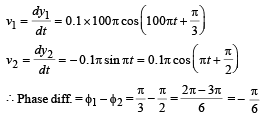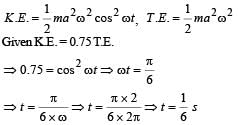All Exams >
JEE >
35 Years Chapter wise Previous Year Solved Papers for JEE >
All Questions
All questions of Simple Harmonic Motion (Oscillations) for JEE Exam
If a simple pendulum has significant amplitude (up to a factor of 1/e of original) only in the period between t = 0s to t = τ s, then τ may be called the average life of the pendulum.
When the spherical bob of the pendulum suffers a retardation (due to viscous drag) proportional to its velocity with b as the constant of proportionality, the average life time of the pendulum is (assuming damping is small) in seconds :- a)0.693/b
- b)b
- c)1/b
- d)2/b
Correct answer is option 'D'. Can you explain this answer?
If a simple pendulum has significant amplitude (up to a factor of 1/e of original) only in the period between t = 0s to t = τ s, then τ may be called the average life of the pendulum.
When the spherical bob of the pendulum suffers a retardation (due to viscous drag) proportional to its velocity with b as the constant of proportionality, the average life time of the pendulum is (assuming damping is small) in seconds :
When the spherical bob of the pendulum suffers a retardation (due to viscous drag) proportional to its velocity with b as the constant of proportionality, the average life time of the pendulum is (assuming damping is small) in seconds :
a)
0.693/b
b)
b
c)
1/b
d)
2/b

|
Ujwal Chawla answered |
The equation of motion for the pendulum, suffering retardation
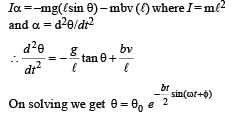

The bob of a simple pendulum is a spherical hollow ball filled with water. A plugged hole near the bottom of the oscillating bob gets suddenly unplugged. During observation, till water is coming out, the time period of oscillation would- a)first decrease and then increase to the original value
- b)first increase and then decrease to the original value
- c)increase towards a saturation value
- d)remain unchanged
Correct answer is option 'B'. Can you explain this answer?
The bob of a simple pendulum is a spherical hollow ball filled with water. A plugged hole near the bottom of the oscillating bob gets suddenly unplugged. During observation, till water is coming out, the time period of oscillation would
a)
first decrease and then increase to the original value
b)
first increase and then decrease to the original value
c)
increase towards a saturation value
d)
remain unchanged

|
Harshitha Nambiar answered |
Centre of mass of combination of liquid and hollow portion (at position ℓ), first goes down (to ℓ + Δℓ) and when total water is drained out, centre of mass regain its original position (to ℓ),

∴ ‘T’ first increases and then decreases to original value.

A mass M is suspended from a spring of negligible mass. The spring is pulled a little and then released so that the mass executes SHM of time period T. If the mass is increased by m, the time period becomes 5T/3. Then the ratio of m/M is- a)3/5
- b)25/9
- c)16/9
- d)5/3
Correct answer is option 'C'. Can you explain this answer?
A mass M is suspended from a spring of negligible mass. The spring is pulled a little and then released so that the mass executes SHM of time period T. If the mass is increased by m, the time period becomes 5T/3. Then the ratio of m/M is
a)
3/5
b)
25/9
c)
16/9
d)
5/3

|
Athira Datta answered |
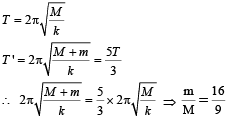
If x, v and a denote the displacement, the velocity and the acceleration of a particle executing simple harmonic motion of time period T, then, which of the following does not change with time?- a)aT/x
- b)aT + 2πv
- c)aT/v
- d)a2T2 + 4p2v2
Correct answer is option 'A'. Can you explain this answer?
If x, v and a denote the displacement, the velocity and the acceleration of a particle executing simple harmonic motion of time period T, then, which of the following does not change with time?
a)
aT/x
b)
aT + 2πv
c)
aT/v
d)
a2T2 + 4p2v2

|
Jatin Dasgupta answered |
For an SHM, the acceleration a = -ω2x where ω2 is a constant. Therefore a/x is a constant. The time period
T is also constant. Therefor aT/x is a constant.
T is also constant. Therefor aT/x is a constant.
A particle executes simple harmonic motion between x = -A and x = +A. The time taken for it to go from 0 to A/2 is T1 and to go from A/2 to A is T2. Then- a)T1 < T2
- b)T1 > T2
- c)T1 = T2
- d)T1 = 2T2
Correct answer is option 'A'. Can you explain this answer?
A particle executes simple harmonic motion between x = -A and x = +A. The time taken for it to go from 0 to A/2 is T1 and to go from A/2 to A is T2. Then
a)
T1 < T2
b)
T1 > T2
c)
T1 = T2
d)
T1 = 2T2
|
|
Diya Iyer answered |
= T2
This statement is not necessarily true. The time taken for the particle to go from 0 to A/2 and from A/2 to A may not be equal in general.
However, if the motion is symmetric about x=0 (i.e., the particle takes the same amount of time to go from 0 to A/2 as it does from 0 to -A/2), then T1 = T2. This is because the total time period of the motion is T = 2T1 = 2T2, and the particle spends half of this time period in each half of the motion, so T1 = T2 = T/2.
This statement is not necessarily true. The time taken for the particle to go from 0 to A/2 and from A/2 to A may not be equal in general.
However, if the motion is symmetric about x=0 (i.e., the particle takes the same amount of time to go from 0 to A/2 as it does from 0 to -A/2), then T1 = T2. This is because the total time period of the motion is T = 2T1 = 2T2, and the particle spends half of this time period in each half of the motion, so T1 = T2 = T/2.
A linear harmonic oscillator of force constant 2 × 106 N/m and amplitude 0.01 m has a total mechanical energy of 160 J.
Its- a)maximum potential energy is 100 J
- b)maximum kinetic energy is 100 J
- c)maximum potential energy is 160 J
- d)maximum potential energy is zero
Correct answer is option 'B,C'. Can you explain this answer?
A linear harmonic oscillator of force constant 2 × 106 N/m and amplitude 0.01 m has a total mechanical energy of 160 J.
Its
Its
a)
maximum potential energy is 100 J
b)
maximum kinetic energy is 100 J
c)
maximum potential energy is 160 J
d)
maximum potential energy is zero

|
Sarthak Khanna answered |
The total energy of the oscillator

As total mechanical energy = 160 J
The P.E. at equilibrium position is not zero.
P.E. at mean position = (160 – 100) J = 60 J
∴ Max P.E. = (100 + 60 ) J = 160 J.
The P.E. at equilibrium position is not zero.
P.E. at mean position = (160 – 100) J = 60 J
∴ Max P.E. = (100 + 60 ) J = 160 J.

Two particles are executing simple harmonic motion of the same amplitude A and frequency ω along the x-axis. Their mean position is separated by distance X0(X0 > A). If the maximum separation between them is (X0 + A), the phase difference between their motion is:- a)π/3
- b)π/4
- c)π/6
- d)π/2
Correct answer is option 'D'. Can you explain this answer?
Two particles are executing simple harmonic motion of the same amplitude A and frequency ω along the x-axis. Their mean position is separated by distance X0(X0 > A). If the maximum separation between them is (X0 + A), the phase difference between their motion is:
a)
π/3
b)
π/4
c)
π/6
d)
π/2

|
Nilesh Goyal answered |
For X0 + A to be the maximum seperation y one body is at the mean position, the other should be at the extreme.
A simple pendulum has time period T1. The point of suspension is now moved upward according to the relation y = Kt2, (K = 1 m/s2) where y is the vertical displacement. The time period now becomes T2. The ratio of  (g = 10 m/s2)
(g = 10 m/s2)- a)5/6
- b)6/5
- c)1
- d)4/5
Correct answer is option 'B'. Can you explain this answer?
A simple pendulum has time period T1. The point of suspension is now moved upward according to the relation y = Kt2, (K = 1 m/s2) where y is the vertical displacement. The time period now becomes T2. The ratio of 

(g = 10 m/s2)
a)
5/6
b)
6/5
c)
1
d)
4/5

|
Jaideep Sengupta answered |


[∵g1 = 10 m/s2 and g2 = g + 2 = 12 m/s2]
A particle moves with simple harmonic motion in a straight line. In first τ s, after starting from rest it travels a distance a, and in next τ s it travels 2a, in same direction, then:- a)amplitude of motion is 3a
- b)time period of oscillations is 8τ
- c)amplitude of motion is 4a
- d)time period of oscillations is 6τ
Correct answer is option 'D'. Can you explain this answer?
A particle moves with simple harmonic motion in a straight line. In first τ s, after starting from rest it travels a distance a, and in next τ s it travels 2a, in same direction, then:
a)
amplitude of motion is 3a
b)
time period of oscillations is 8τ
c)
amplitude of motion is 4a
d)
time period of oscillations is 6τ
|
|
Disha Mishra answered |
In simple harmonic motion, starting from rest,
At t = 0 , x = A
x = Acosωt ..... (i)
When t = τ , x = A – a
When t = 2 τ , x = A –3a
From equation (i)
A – a = Acosω τ ......(ii)
A – 3a = A cos2ω τ ......(iii)
As cos2ωτ = 2 cos2 ωτ – 1 …(iv)
x = Acosωt ..... (i)
When t = τ , x = A – a
When t = 2 τ , x = A –3a
From equation (i)
A – a = Acosω τ ......(ii)
A – 3a = A cos2ω τ ......(iii)
As cos2ωτ = 2 cos2 ωτ – 1 …(iv)
From equation (ii), (iii) and (iv)
 |
|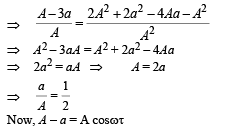

A particle of mass m is attached to a spring (of spring constant k) and has a natural angular frequency ω0. An external force F(t) pr opor tion al to cos ωt (ω ≠ ω0) is applied to th e oscillator. The time displacement of the oscillator will be proportional to- a)

- b)

- c)

- d)

Correct answer is option 'B'. Can you explain this answer?
A particle of mass m is attached to a spring (of spring constant k) and has a natural angular frequency ω0. An external force F(t) pr opor tion al to cos ωt (ω ≠ ω0) is applied to th e oscillator. The time displacement of the oscillator will be proportional to
a)

b)

c)

d)


|
Ujwal Chawla answered |
Equation of displacement is given by
x = A sin(ωt +φ)

Phase space diagrams are useful tools in analyzing all kinds of dynamical problems. They are especially useful in studying the changes in motion as initial position and momenum are changed.
Here we consider some simple dynamical systems in one dimension. For such systems, phase space is a plane in which position is plotted along horizontal axis and momentum is plotted along vertical axis. The phase space diagram is x(t) vs. p(t) curve in this plane. The arrow on the curve indicates the time flow. For example, the phase space diagram for a particle moving with constant velocity is a straight line as shown in the figure. We use the sign convention in which positon or momentum upwards (or to right) is positive and downwards (or to left) is negative.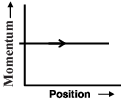 Q. Consider the spring-mass system, with the mass submerged in water, as shown in the figure. The phase space diagram for one cycle of this system is
Q. Consider the spring-mass system, with the mass submerged in water, as shown in the figure. The phase space diagram for one cycle of this system is
- a)
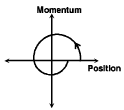
- b)
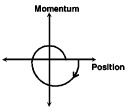
- c)
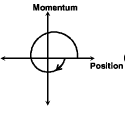
- d)
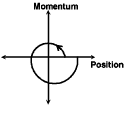
Correct answer is option 'B'. Can you explain this answer?
Phase space diagrams are useful tools in analyzing all kinds of dynamical problems. They are especially useful in studying the changes in motion as initial position and momenum are changed.
Here we consider some simple dynamical systems in one dimension. For such systems, phase space is a plane in which position is plotted along horizontal axis and momentum is plotted along vertical axis. The phase space diagram is x(t) vs. p(t) curve in this plane. The arrow on the curve indicates the time flow. For example, the phase space diagram for a particle moving with constant velocity is a straight line as shown in the figure. We use the sign convention in which positon or momentum upwards (or to right) is positive and downwards (or to left) is negative.
Here we consider some simple dynamical systems in one dimension. For such systems, phase space is a plane in which position is plotted along horizontal axis and momentum is plotted along vertical axis. The phase space diagram is x(t) vs. p(t) curve in this plane. The arrow on the curve indicates the time flow. For example, the phase space diagram for a particle moving with constant velocity is a straight line as shown in the figure. We use the sign convention in which positon or momentum upwards (or to right) is positive and downwards (or to left) is negative.

Q. Consider the spring-mass system, with the mass submerged in water, as shown in the figure. The phase space diagram for one cycle of this system is

a)

b)

c)

d)


|
Subhankar Mukherjee answered |
As the mass is osicillating in water its amplitude will go on decreasing and the amplitude will decrease with time. Options (c) and (d) cannot be true.
When the position of the mass is at one extreme end in the positive side (the topmost point), the momentum is zero. As the mass moves towards the mean position the momentum increases in the negative direction.
These characteristics are depicted in option (b).
When the position of the mass is at one extreme end in the positive side (the topmost point), the momentum is zero. As the mass moves towards the mean position the momentum increases in the negative direction.
These characteristics are depicted in option (b).
For a simple pendulum, a graph is plotted between its kinetic energy (KE) and potential energy (PE) against its displacement d.
Which one of the following represents these correctly? (graphs are schematic and not drawn to scale)- a)
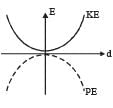
- b)
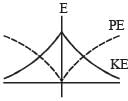
- c)

- d)

Correct answer is option 'D'. Can you explain this answer?
For a simple pendulum, a graph is plotted between its kinetic energy (KE) and potential energy (PE) against its displacement d.
Which one of the following represents these correctly? (graphs are schematic and not drawn to scale)
Which one of the following represents these correctly? (graphs are schematic and not drawn to scale)
a)

b)

c)

d)


|
Nikhil Sen answered |

At mean position d = 0. At extremes positions d = A
One end of a long metallic wire of length L is tied to the ceiling. The other end is tied to a massless spring of spring constant K.A mass m hangs freely from the free end of the spring. The area of cross-section and the Young’s modulus of the wire are A and Y respectively. If the mass is slightly pulled down and released, it will oscillate with a time period T equal to:- a)2π(m /K)1/2
- b)

- c)2π[(mYA / KL)1/2
- d)2π[(mL / YA)1/2
Correct answer is option 'B'. Can you explain this answer?
One end of a long metallic wire of length L is tied to the ceiling. The other end is tied to a massless spring of spring constant K.A mass m hangs freely from the free end of the spring. The area of cross-section and the Young’s modulus of the wire are A and Y respectively. If the mass is slightly pulled down and released, it will oscillate with a time period T equal to:
a)
2π(m /K)1/2
b)

c)
2π[(mYA / KL)1/2
d)
2π[(mL / YA)1/2

|
Sahana Joshi answered |
Let us consider the wire also as a spring. Then the case becomes that of two spring attached in series. The equivalent spring constant is

where k' is the spring constant of the wire

We know that time period of the system

A highly rigid cubical block A of small mass M and side L is fixed rigidly on to another cubical block B of the same dimensions and of low modulus of rigidity η such that the lower face of A completely covers the upper face of B. The lower face of B is rigidly held on a horizontal surface. A small force F is applied perpendicular to one of the sides faces of A. After the force is withdrawn, block A executes small oscillations the time period of which is given by- a)

- b)

- c)

- d)

Correct answer is option 'D'. Can you explain this answer?
A highly rigid cubical block A of small mass M and side L is fixed rigidly on to another cubical block B of the same dimensions and of low modulus of rigidity η such that the lower face of A completely covers the upper face of B. The lower face of B is rigidly held on a horizontal surface. A small force F is applied perpendicular to one of the sides faces of A. After the force is withdrawn, block A executes small oscillations the time period of which is given by
a)

b)

c)

d)


|
Mira Roy answered |
NOTE : When a force is applied on cubical block A in the horizontal direction then the lower block B will get distorted as shown by dotted lines and A will attain a new position (without distortion as A is a rigid body) as shown by dotted lines.
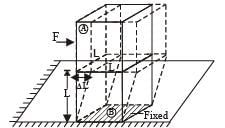
For cubical block B

⇒ F = ηLΔL
ηL is a constant
⇒ Force F ∝ ΔL and directed towards the mean position, oscillation will be simple harmonic in nature.
Here, Mω2 = ηL
Here, Mω2 = ηL

Two bodies M and N of equal masses are suspended from two separate massless springs of spring constants k1 and k2 respectively. If the two bodies oscillate vertically such that their maximum velocities are equal, the ratio of the amplitude of vibration of M to that of N is- a)

- b)

- c)

- d)

Correct answer is option 'D'. Can you explain this answer?
Two bodies M and N of equal masses are suspended from two separate massless springs of spring constants k1 and k2 respectively. If the two bodies oscillate vertically such that their maximum velocities are equal, the ratio of the amplitude of vibration of M to that of N is
a)

b)

c)

d)


|
Tejas Chawla answered |
Both the bodies oscillate in simple harmonic motion, for which the maximum velocities will be


When a particle of mass m moves on the x-axis in a potential of the form V(x) = kx2 it performs simple harmonic motion. The corresponding time period is proportional to  as can be seen easily using dimensional analysis. However, the motion of a particle can be periodic even when its potential energy increases on both sides of x = 0 in a way different from kx2 and its total energy is such that the particle does not escape to infinity. Consider a particle of mass m moving on the x-axis. Its potential energy is V(x) = αx4 (α > 0) for |x| near the origin and becomes a constant equal to V0 for |x| > X0 (see figure).
as can be seen easily using dimensional analysis. However, the motion of a particle can be periodic even when its potential energy increases on both sides of x = 0 in a way different from kx2 and its total energy is such that the particle does not escape to infinity. Consider a particle of mass m moving on the x-axis. Its potential energy is V(x) = αx4 (α > 0) for |x| near the origin and becomes a constant equal to V0 for |x| > X0 (see figure).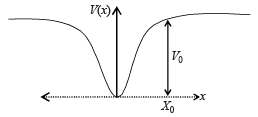 Q. The acceleration of this particle for |x| > X0 is
Q. The acceleration of this particle for |x| > X0 is- a)proportional to V0
- b)proportional to

- c)proportional to

- d)zero
Correct answer is option 'D'. Can you explain this answer?
When a particle of mass m moves on the x-axis in a potential of the form V(x) = kx2 it performs simple harmonic motion. The corresponding time period is proportional to  as can be seen easily using dimensional analysis. However, the motion of a particle can be periodic even when its potential energy increases on both sides of x = 0 in a way different from kx2 and its total energy is such that the particle does not escape to infinity. Consider a particle of mass m moving on the x-axis. Its potential energy is V(x) = αx4 (α > 0) for |x| near the origin and becomes a constant equal to V0 for |x| > X0 (see figure).
as can be seen easily using dimensional analysis. However, the motion of a particle can be periodic even when its potential energy increases on both sides of x = 0 in a way different from kx2 and its total energy is such that the particle does not escape to infinity. Consider a particle of mass m moving on the x-axis. Its potential energy is V(x) = αx4 (α > 0) for |x| near the origin and becomes a constant equal to V0 for |x| > X0 (see figure).
 as can be seen easily using dimensional analysis. However, the motion of a particle can be periodic even when its potential energy increases on both sides of x = 0 in a way different from kx2 and its total energy is such that the particle does not escape to infinity. Consider a particle of mass m moving on the x-axis. Its potential energy is V(x) = αx4 (α > 0) for |x| near the origin and becomes a constant equal to V0 for |x| > X0 (see figure).
as can be seen easily using dimensional analysis. However, the motion of a particle can be periodic even when its potential energy increases on both sides of x = 0 in a way different from kx2 and its total energy is such that the particle does not escape to infinity. Consider a particle of mass m moving on the x-axis. Its potential energy is V(x) = αx4 (α > 0) for |x| near the origin and becomes a constant equal to V0 for |x| > X0 (see figure).
Q. The acceleration of this particle for |x| > X0 is
a)
proportional to V0
b)
proportional to 

c)
proportional to 

d)
zero

|
Sanchita Patel answered |

As V (x) = constant for x > X0
∴ F = 0 for x > X0
Since F = 0, a = 0
∴ F = 0 for x > X0
Since F = 0, a = 0
A child swinging on a swing in sitting position, stands up, then the time period of the swing will- a)increase
- b)decrease
- c)remains same
- d)increases of the child is long and decreases if the child is short
Correct answer is option 'B'. Can you explain this answer?
A child swinging on a swing in sitting position, stands up, then the time period of the swing will
a)
increase
b)
decrease
c)
remains same
d)
increases of the child is long and decreases if the child is short

|
Rithika Mishra answered |
Let the spring constant of the original spring be k. Then its time period  where m is the mass of
where m is the mass of
oscillating body.
When the spring is cut into n equal parts, the spring constant of one part becomes nk. Therefore the new time period,
 where m is the mass of
where m is the mass ofoscillating body.
When the spring is cut into n equal parts, the spring constant of one part becomes nk. Therefore the new time period,

A body executes simple harmonic motion. The potential energy (P.E), the kinetic energy (K.E) and total energy (T.E) are measured as a function of displacement x. Which of the following statements is true ?- a)K.E. is maximum when x = 0
- b)T.E is zero when x = 0
- c)K.E is maximum when x is maximum
- d)P.E is maximum when x = 0
Correct answer is option 'A'. Can you explain this answer?
A body executes simple harmonic motion. The potential energy (P.E), the kinetic energy (K.E) and total energy (T.E) are measured as a function of displacement x. Which of the following statements is true ?
a)
K.E. is maximum when x = 0
b)
T.E is zero when x = 0
c)
K.E is maximum when x is maximum
d)
P.E is maximum when x = 0

|
Sinjini Datta answered |

When x = 0, K.E is maximum and is equal to 

A particle at the end of a spring executes S.H.M with a period t1. while the corresponding period for another spring is t2. If the period of oscillation with the two springs in series is T then- a)

- b)

- c)T = t1+t2
- d)

Correct answer is option 'B'. Can you explain this answer?
A particle at the end of a spring executes S.H.M with a period t1. while the corresponding period for another spring is t2. If the period of oscillation with the two springs in series is T then
a)

b)

c)
T = t1+t2
d)


|
Nishanth Verma answered |
For first spring, 

For second spring, 

when springs are in series then, 

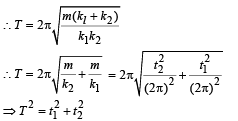
where x is the displacement from the mean position
In forced oscillation of a particle the amplitude is maximum for a frequency ω1 of the force while the energy is maximum for a frequency ω2 of the force; then- a)ω1 < ω2 when damping is small and ω1 > ω2 when damping is large
- b)ω1 > ω2
- c)ω1 = ω2
- d)ω1 < ω2
Correct answer is option 'C'. Can you explain this answer?
In forced oscillation of a particle the amplitude is maximum for a frequency ω1 of the force while the energy is maximum for a frequency ω2 of the force; then
a)
ω1 < ω2 when damping is small and ω1 > ω2 when damping is large
b)
ω1 > ω2
c)
ω1 = ω2
d)
ω1 < ω2

|
Athira Datta answered |
The maximum of amplitude and energy is obtained when the frequency is equal to the natural frequency (resonance condition)
∴ w1 = w2
∴ w1 = w2
A block with mass M is conn ected by a massless spring with stiffness constant k to a rigid wall and moves without friction on a horizontal surface. The block oscillates with small amplitude A about an equilibrium position x0. Consider two cases: (i) when the block is at x0; and (ii) when the block is at x = x0 + A. In both the cases, a particle with mass m(<M) is softly placed on the block after which they stick to each other. Which of the following statement(s) is (are) true about the motion after the mass m is placed on the mass M?- a)The amplitude of oscillation in the first case chan ges by a factor of
 whereas in the second case it remains unchanged.
whereas in the second case it remains unchanged. - b)The final time period of oscillation in both the cases is same.
- c)The total energy decreases in both the cases.
- d)The instantaneous speed at x0 of the combined masses decreases in both the cases
Correct answer is option 'A,B,D'. Can you explain this answer?
A block with mass M is conn ected by a massless spring with stiffness constant k to a rigid wall and moves without friction on a horizontal surface. The block oscillates with small amplitude A about an equilibrium position x0. Consider two cases: (i) when the block is at x0; and (ii) when the block is at x = x0 + A. In both the cases, a particle with mass m(<M) is softly placed on the block after which they stick to each other. Which of the following statement(s) is (are) true about the motion after the mass m is placed on the mass M?
a)
The amplitude of oscillation in the first case chan ges by a factor of  whereas in the second case it remains unchanged.
whereas in the second case it remains unchanged.
 whereas in the second case it remains unchanged.
whereas in the second case it remains unchanged.b)
The final time period of oscillation in both the cases is same.
c)
The total energy decreases in both the cases.
d)
The instantaneous speed at x0 of the combined masses decreases in both the cases

|
Mira Roy answered |
Case (i) : Applying conservation of linear momentum.


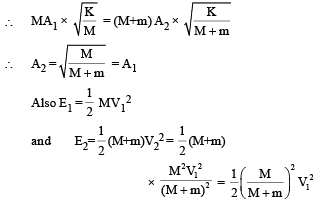
Clearly E2 < E1
The new time Period
Case (ii) : The new time Period



Clearly E2 < E1
The new time Period

Case (ii) : The new time Period

Also A2 = A1
Here E2 = E1
The instantaneous value of speed at Xo of the combined masses decreases in both the cases.
Here E2 = E1
The instantaneous value of speed at Xo of the combined masses decreases in both the cases.
A small block is connected to one end of a massless spring of un-stretched length 4.9 m. The other end of the spring (see the figure) is fixed. The system lies on a horizontal frictionless surface. The block is stretched by 0.2 m and released from rest at t = 0. It then executes simple harmonic motion with angular frequency ω = π/3 rad/s. Simultaneously at t = 0, a small pebble is projected with speed v form point P at an angle of 45° as shown in the figure. Point P is at a horizontal distance of 10 m from O. If the pebble hits the block at t = 1 s, the value of v is (take g = 10 m/s2)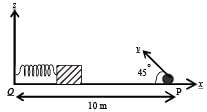
- a)

- b)

- c)

- d)

Correct answer is option 'A'. Can you explain this answer?
A small block is connected to one end of a massless spring of un-stretched length 4.9 m. The other end of the spring (see the figure) is fixed. The system lies on a horizontal frictionless surface. The block is stretched by 0.2 m and released from rest at t = 0. It then executes simple harmonic motion with angular frequency ω = π/3 rad/s. Simultaneously at t = 0, a small pebble is projected with speed v form point P at an angle of 45° as shown in the figure. Point P is at a horizontal distance of 10 m from O. If the pebble hits the block at t = 1 s, the value of v is (take g = 10 m/s2)

a)

b)

c)

d)


|
Nandini Nair answered |

A mass M, attached to a horizontal spring, executes S.H.M. with amplitude A1. When the mass M passes through its mean position then a smaller mass m is placed over it and both of them move together with amplitude A2. The ratio of 
- a)

- b)

- c)

- d)

Correct answer is option 'C'. Can you explain this answer?
A mass M, attached to a horizontal spring, executes S.H.M. with amplitude A1. When the mass M passes through its mean position then a smaller mass m is placed over it and both of them move together with amplitude A2. The ratio of 

a)

b)

c)

d)


|
Sahana Ahuja answered |
The net force becomes zero at the mean point.
Therefore, linear momentum must be conserved.
Therefore, linear momentum must be conserved.
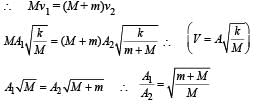
A particle free to move along the x-axis has potential energy given by U(x) = k [1–exp(–x2)] for -∞ < x < + ∞, where k is a positive constant of appropriate dimensions. Then- a)at points away from the origin, the particle is in unstable equilibrium
- b)for any finite nonzero value of x, there is a force directed away from the origin
- c)if its total mechanical energy is k/2, it has its minimum kinetic energy at the origin.
- d)for small displacements from x = 0, the motion is simple harmonic
Correct answer is option 'D'. Can you explain this answer?
A particle free to move along the x-axis has potential energy given by U(x) = k [1–exp(–x2)] for -∞ < x < + ∞, where k is a positive constant of appropriate dimensions. Then
a)
at points away from the origin, the particle is in unstable equilibrium
b)
for any finite nonzero value of x, there is a force directed away from the origin
c)
if its total mechanical energy is k/2, it has its minimum kinetic energy at the origin.
d)
for small displacements from x = 0, the motion is simple harmonic

|
Rounak Desai answered |
Let us plot the graph of the mathematical equation

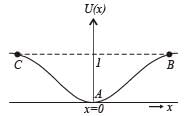
From the graph it is clear that the potential energy is minimum at x = 0. Therefore, x = 0 is the state of stable equilibrium. Now if we displace the particle from x = 0 then for displacements the particle tends to regain the position x = 0 with a force  Therefore for small
Therefore for small
values of x we have F ∝ x.
 Therefore for small
Therefore for smallvalues of x we have F ∝ x.
A point mass is subjected to two simultaneous sinusoidal displacements in x-direction, x1(t) = A sin wt and x2(t) =  Adding a third sinusoidal displacement x3(t) = B sin (ωt + φ) brings the mass to a complete rest. The values of B and φ are
Adding a third sinusoidal displacement x3(t) = B sin (ωt + φ) brings the mass to a complete rest. The values of B and φ are- a)

- b)

- c)

- d)

Correct answer is option 'B'. Can you explain this answer?
A point mass is subjected to two simultaneous sinusoidal displacements in x-direction, x1(t) = A sin wt and x2(t) =  Adding a third sinusoidal displacement x3(t) = B sin (ωt + φ) brings the mass to a complete rest. The values of B and φ are
Adding a third sinusoidal displacement x3(t) = B sin (ωt + φ) brings the mass to a complete rest. The values of B and φ are
 Adding a third sinusoidal displacement x3(t) = B sin (ωt + φ) brings the mass to a complete rest. The values of B and φ are
Adding a third sinusoidal displacement x3(t) = B sin (ωt + φ) brings the mass to a complete rest. The values of B and φ area)

b)

c)

d)


|
Bhavya Joshi answered |
Two sinusoidal displacements have amplitude A each, with a phase difference of  It is given that sinusoidal displacement x3(t) brings the mass to a complete rest. This is possible when the amplitude of third is A and is having a phase difference of
It is given that sinusoidal displacement x3(t) brings the mass to a complete rest. This is possible when the amplitude of third is A and is having a phase difference of  with
with
respect to x1 (t) as shown in the figure.
 It is given that sinusoidal displacement x3(t) brings the mass to a complete rest. This is possible when the amplitude of third is A and is having a phase difference of
It is given that sinusoidal displacement x3(t) brings the mass to a complete rest. This is possible when the amplitude of third is A and is having a phase difference of  with
withrespect to x1 (t) as shown in the figure.
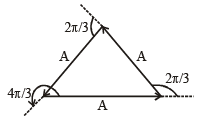
A particle executes simple harmonic motion with a frequency. f. The frequency with which its kinetic energy oscillates is- a)f/2
- b)f
- c)2f
- d)4f
Correct answer is option 'C'. Can you explain this answer?
A particle executes simple harmonic motion with a frequency. f. The frequency with which its kinetic energy oscillates is
a)
f/2
b)
f
c)
2f
d)
4f

|
Devansh Joshi answered |
NOTE : During one complete oscillation, the kinetic energy will become maximum twice.
Therefore the frequency of kinetic energy will be 2f.
Therefore the frequency of kinetic energy will be 2f.
Two independent harmonic oscillators of equal mass are oscillating about the origin with angular frequencies ω1 and ω2 and have total energies E1 and E2, respectively. The variations of their momenta p with positions x are shown in the figures.  then the correct equation(s) is(are)
then the correct equation(s) is(are)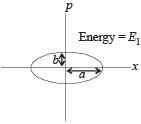
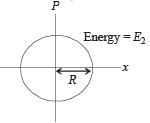
- a)E1ω1 = E2ω2
- b)

- c)ω1ω2 = n2
- d)

Correct answer is option 'B,D'. Can you explain this answer?
Two independent harmonic oscillators of equal mass are oscillating about the origin with angular frequencies ω1 and ω2 and have total energies E1 and E2, respectively. The variations of their momenta p with positions x are shown in the figures.  then the correct equation(s) is(are)
then the correct equation(s) is(are)
 then the correct equation(s) is(are)
then the correct equation(s) is(are)

a)
E1ω1 = E2ω2
b)

c)
ω1ω2 = n2
d)


|
Mihir Patel answered |
Maximum linear momentum in case 1 is (p1)max = mvmax
b = m [aw1] ...(i)
Maximum linear momentum in case 2 is (p2)max = mvmax
R = m [Rω2]
b = m [aw1] ...(i)
Maximum linear momentum in case 2 is (p2)max = mvmax
R = m [Rω2]
∴ 1 = mω2 ...(ii)
Dividing (i) & (ii) 

 ∴ B is a correct option.
∴ B is a correct option.

Two particles A and B of equal masses are suspended from two massless springs of spring of spring constant k1 and k2, respectively. If the maximum velocities, during oscillation, are equal, the ratio of amplitude of A and B is- a)

- b)

- c)

- d)

Correct answer is option 'C'. Can you explain this answer?
Two particles A and B of equal masses are suspended from two massless springs of spring of spring constant k1 and k2, respectively. If the maximum velocities, during oscillation, are equal, the ratio of amplitude of A and B is
a)

b)

c)

d)


|
Anjali Deshpande answered |
Maximum velocity during SHM 


Here the maximum velocity is same and m is also same

The amplitude of a damped oscillator decreases to 0.9 times its original magnitude in 5s. In another 10s it will decrease to a times its original magnitude, where α equals- a)0.7
- b)0.81
- c)0.729
- d)0.6
Correct answer is option 'C'. Can you explain this answer?
The amplitude of a damped oscillator decreases to 0.9 times its original magnitude in 5s. In another 10s it will decrease to a times its original magnitude, where α equals
a)
0.7
b)
0.81
c)
0.729
d)
0.6

|
Tejas Chawla answered |
 (where, A0 = maximum amplitude)
(where, A0 = maximum amplitude)According to the questions, after 5 second,

From eqns (i) and (ii)
A = 0.729 A0 ∴ α = 0.729
A = 0.729 A0 ∴ α = 0.729
A point mass oscillates along the x-axis according to the law x = x0 cos(ωt -π / 4) . If the acceleration of the particle is written as a = A cos(wt +δ) ,then- a)A = x0 ω2 , δ = 3π /4
- b) A = x0, δ =-π /4
- c)A = x0ω2 , δ = π/4
- d)A = x0ω2, δ = -π/4
Correct answer is option 'A'. Can you explain this answer?
A point mass oscillates along the x-axis according to the law x = x0 cos(ωt -π / 4) . If the acceleration of the particle is written as a = A cos(wt +δ) ,then
a)
A = x0 ω2 , δ = 3π /4
b)
A = x0, δ =-π /4
c)
A = x0ω2 , δ = π/4
d)
A = x0ω2, δ = -π/4

|
Sanchita Patel answered |
Here,

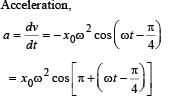
 ...(1)
...(1)Acceleration, a = A cos (ωt + δ) ...(2)
Comparing the two equations, we get

When a particle of mass m moves on the x-axis in a potential of the form V(x) = kx2 it performs simple harmonic motion. The corresponding time period is proportional to  as can be seen easily using dimensional analysis. However, the motion of a particle can be periodic even when its potential energy increases on both sides of x = 0 in a way different from kx2 and its total energy is such that the particle does not escape to infinity. Consider a particle of mass m moving on the x-axis. Its potential energy is V(x) = αx4 (α > 0) for |x| near the origin and becomes a constant equal to V0 for |x| > X0 (see figure).
as can be seen easily using dimensional analysis. However, the motion of a particle can be periodic even when its potential energy increases on both sides of x = 0 in a way different from kx2 and its total energy is such that the particle does not escape to infinity. Consider a particle of mass m moving on the x-axis. Its potential energy is V(x) = αx4 (α > 0) for |x| near the origin and becomes a constant equal to V0 for |x| > X0 (see figure). Q. For periodic motion of small amplitude A, the time period T of this particle is proportional to
Q. For periodic motion of small amplitude A, the time period T of this particle is proportional to- a)

- b)

- c)

- d)

Correct answer is option 'B'. Can you explain this answer?
When a particle of mass m moves on the x-axis in a potential of the form V(x) = kx2 it performs simple harmonic motion. The corresponding time period is proportional to  as can be seen easily using dimensional analysis. However, the motion of a particle can be periodic even when its potential energy increases on both sides of x = 0 in a way different from kx2 and its total energy is such that the particle does not escape to infinity. Consider a particle of mass m moving on the x-axis. Its potential energy is V(x) = αx4 (α > 0) for |x| near the origin and becomes a constant equal to V0 for |x| > X0 (see figure).
as can be seen easily using dimensional analysis. However, the motion of a particle can be periodic even when its potential energy increases on both sides of x = 0 in a way different from kx2 and its total energy is such that the particle does not escape to infinity. Consider a particle of mass m moving on the x-axis. Its potential energy is V(x) = αx4 (α > 0) for |x| near the origin and becomes a constant equal to V0 for |x| > X0 (see figure).
 as can be seen easily using dimensional analysis. However, the motion of a particle can be periodic even when its potential energy increases on both sides of x = 0 in a way different from kx2 and its total energy is such that the particle does not escape to infinity. Consider a particle of mass m moving on the x-axis. Its potential energy is V(x) = αx4 (α > 0) for |x| near the origin and becomes a constant equal to V0 for |x| > X0 (see figure).
as can be seen easily using dimensional analysis. However, the motion of a particle can be periodic even when its potential energy increases on both sides of x = 0 in a way different from kx2 and its total energy is such that the particle does not escape to infinity. Consider a particle of mass m moving on the x-axis. Its potential energy is V(x) = αx4 (α > 0) for |x| near the origin and becomes a constant equal to V0 for |x| > X0 (see figure).
Q. For periodic motion of small amplitude A, the time period T of this particle is proportional to
a)

b)

c)

d)


|
Rithika Mishra answered |
We can get the answer of this question with the help of dimensional analysis.
Given potential energy = αx4

Therefore option (b) is correct.
Phase space diagrams are useful tools in analyzing all kinds of dynamical problems. They are especially useful in studying the changes in motion as initial position and momenum are changed.
Here we consider some simple dynamical systems in one dimension. For such systems, phase space is a plane in which position is plotted along horizontal axis and momentum is plotted along vertical axis. The phase space diagram is x(t) vs. p(t) curve in this plane. The arrow on the curve indicates the time flow. For example, the phase space diagram for a particle moving with constant velocity is a straight line as shown in the figure. We use the sign convention in which positon or momentum upwards (or to right) is positive and downwards (or to left) is negative. Q. The phase space diagram for a ball thrown vertically up from ground is
Q. The phase space diagram for a ball thrown vertically up from ground is- a)
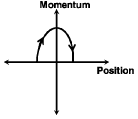
- b)
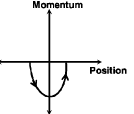
- c)

- d)
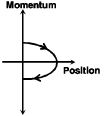
Correct answer is option 'D'. Can you explain this answer?
Phase space diagrams are useful tools in analyzing all kinds of dynamical problems. They are especially useful in studying the changes in motion as initial position and momenum are changed.
Here we consider some simple dynamical systems in one dimension. For such systems, phase space is a plane in which position is plotted along horizontal axis and momentum is plotted along vertical axis. The phase space diagram is x(t) vs. p(t) curve in this plane. The arrow on the curve indicates the time flow. For example, the phase space diagram for a particle moving with constant velocity is a straight line as shown in the figure. We use the sign convention in which positon or momentum upwards (or to right) is positive and downwards (or to left) is negative.
Here we consider some simple dynamical systems in one dimension. For such systems, phase space is a plane in which position is plotted along horizontal axis and momentum is plotted along vertical axis. The phase space diagram is x(t) vs. p(t) curve in this plane. The arrow on the curve indicates the time flow. For example, the phase space diagram for a particle moving with constant velocity is a straight line as shown in the figure. We use the sign convention in which positon or momentum upwards (or to right) is positive and downwards (or to left) is negative.

Q. The phase space diagram for a ball thrown vertically up from ground is
a)

b)

c)

d)


|
Sahana Ahuja answered |
When the ball is thrown upwards, at the point of throw (O) the linear momentum is in upwards direction (and has a maximum value ) and the position is zero. As the time passes, the ball moves upwards and its momentum goes on decreasing and the position becomes positive. The momentum becomes zero at the topmost point (A).

As the time increases, the ball starts moving down with an increasing linear momentum in the downward direction (negative) and reaches back to its original position.
These characteristics are represented by graph (d).
These characteristics are represented by graph (d).
A uniform cylinder of length L and mass M having cross sectional area A is suspended, with its length vertical, from a fixed point by a massless spring, such that it is half- submerged in a liquid of density ρ at equilibrium position. When the cylinder is given a small downward push and released it starts oscillating vertically with small amplitude. If the force constant of the spring is k, the frequency of oscillation of the cylinder is- a)

- b)

- c)

- d)

Correct answer is option 'B'. Can you explain this answer?
A uniform cylinder of length L and mass M having cross sectional area A is suspended, with its length vertical, from a fixed point by a massless spring, such that it is half- submerged in a liquid of density ρ at equilibrium position. When the cylinder is given a small downward push and released it starts oscillating vertically with small amplitude. If the force constant of the spring is k, the frequency of oscillation of the cylinder is
a)

b)

c)

d)


|
Mihir Patel answered |
If x is the displacement then,

The x-t graph of a particle undergoing simple harmonic motion is shown below. The acceleration of the particle at t = 4 / 3 s is
- a)

- b)

- c)

- d)

Correct answer is option 'D'. Can you explain this answer?
The x-t graph of a particle undergoing simple harmonic motion is shown below. The acceleration of the particle at t = 4 / 3 s is

a)

b)

c)

d)


|
Nandini Nair answered |
From the graph it is clear that the amplitude is 1 cm and the time period is 8 second. Therefore the equation for the S.H.M. is

The velocity (v) of the particle at any instant of time ‘t’ is

The acceleration of the particle is



The mass M shown in the figure oscillates in simple harmonic motion with amplitude A. The amplitude of the point P is
- a)

- b)

- c)

- d)

Correct answer is option 'D'. Can you explain this answer?
The mass M shown in the figure oscillates in simple harmonic motion with amplitude A. The amplitude of the point P is

a)

b)

c)

d)


|
Rounak Desai answered |
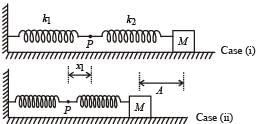
In case (ii), the springs are shown in the maximum compressed position. If the spring of spring constant k1 is compressed by x1 and that of spring constant k2 is compressed by x2 then
x1 + x2 = A … (i)


The function x = A sin2 ωt + B cos2 ωt + C sin ωt cosωt represent SHM for which of the option(s)- a)for all value of A, B and C (C ≠ 0)
- b)A = B, C = 2B
- c)A = -B, C = 2B
- d)A = B, C = 0
Correct answer is option 'A,B,C'. Can you explain this answer?
The function x = A sin2 ωt + B cos2 ωt + C sin ωt cosωt represent SHM for which of the option(s)
a)
for all value of A, B and C (C ≠ 0)
b)
A = B, C = 2B
c)
A = -B, C = 2B
d)
A = B, C = 0

|
Jaideep Sengupta answered |
The given equation is
x = A sin2 ωt + B cos2 ωt + C sin ωt cos ωt
NOTE THIS STEP
Rearranging the equation in a meaningful form (for interpretation of SHM)


The above equation is that of SHM with amplitude C/2 and angular frequency 2ω. Thus option (a) is correct.
(b) If A = B and C = 2B then x = B + B sin 2ωt
This is equation of SHM. The mean position of the particle executing SHM is not at the origin.
Option (b) is correct.
(c) A = – B, C = 2B; Therefore
x = B cos 2ωt + B sin 2ωt
Let B = X cos φ = X sin φ then
x = X sin 2ωt cos φ + X cos 2ωt sin φ This represents equation of SHM.
(d) A = B, C = 0 and x = A.
This equation does not represents SHM.
This is equation of SHM. The mean position of the particle executing SHM is not at the origin.
Option (b) is correct.
(c) A = – B, C = 2B; Therefore
x = B cos 2ωt + B sin 2ωt
Let B = X cos φ = X sin φ then
x = X sin 2ωt cos φ + X cos 2ωt sin φ This represents equation of SHM.
(d) A = B, C = 0 and x = A.
This equation does not represents SHM.
A particle performs simple harmonic mition with amplitude A. Its speed is tripled at the instant that it is at a distance 2A/3 from equilibrium position. The new amplitude of themotion is :
- a)

- b)7A/3
- c)

- d)3A
Correct answer is option 'B'. Can you explain this answer?
A particle performs simple harmonic mition with amplitude A. Its speed is tripled at the instant that it is at a distance 2A/3 from equilibrium position. The new amplitude of themotion is :
a)

b)
7A/3
c)

d)
3A

|
Pranavi Chavan answered |
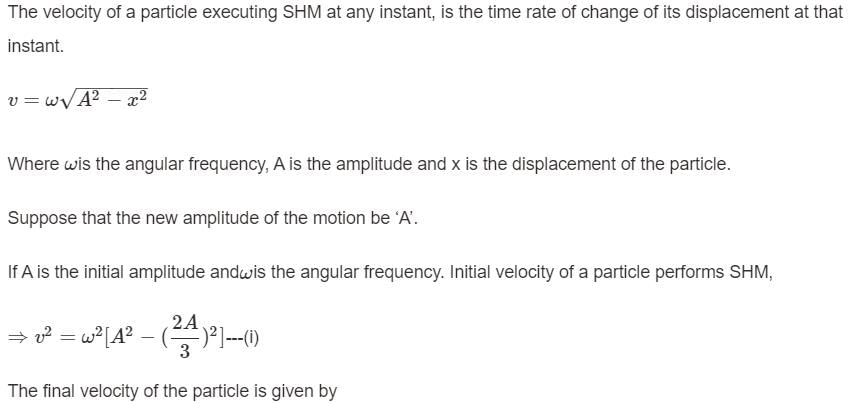
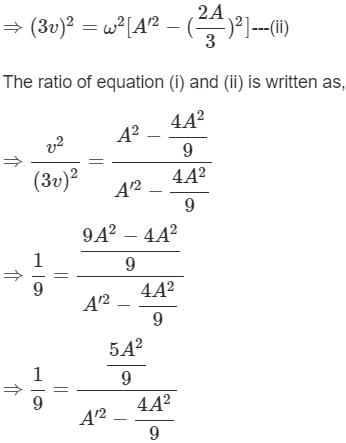
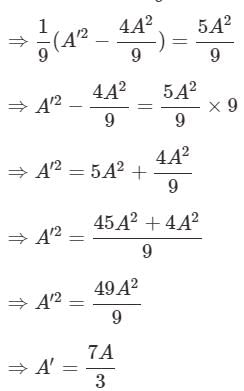
The new amplitude of the motion is 7A/3.
A uniform rod of length L and mass M is pivoted at the centre. Its two ends are attached to two springs of equal spring constants k. The springs are fixed to rigid supports as shown in the figure, and the rod is free to oscillate in the horizontal plane.
The rod is gently pushed through a small angle θ in one direction and released. The frequency of oscillation is
- a)

- b)

- c)

- d)

Correct answer is option 'C'. Can you explain this answer?
A uniform rod of length L and mass M is pivoted at the centre. Its two ends are attached to two springs of equal spring constants k. The springs are fixed to rigid supports as shown in the figure, and the rod is free to oscillate in the horizontal plane.
The rod is gently pushed through a small angle θ in one direction and released. The frequency of oscillation is
The rod is gently pushed through a small angle θ in one direction and released. The frequency of oscillation is

a)

b)

c)

d)


|
Jatin Dasgupta answered |
Figure shows the rod at an angle θ with respect to its equilibrium position. Both the springs are stretched by length

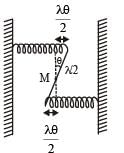
The restoring torque due to the springs τ = – 2 (Restoring force) × perpendicular distance
 ... (i)
... (i)If I is the moment of inertia of the rod about M then
 … (ii)
… (ii)From (i) & (ii) we get



Comparing it with the standard equation of rotational SHM we get

The displacement of an object attached to a spring and executing simple harmonic motion is given by x = 2 × 10–2 cos πt metre.The time at which the maximum speed first occurs is- a)0.25 s
- b)0.5 s
- c)0.75 s
- d)0.125 s
Correct answer is option 'B'. Can you explain this answer?
The displacement of an object attached to a spring and executing simple harmonic motion is given by x = 2 × 10–2 cos πt metre.The time at which the maximum speed first occurs is
a)
0.25 s
b)
0.5 s
c)
0.75 s
d)
0.125 s

|
Avantika Saha answered |

For the first time, the speed to be maximum,

The bob of a simple pendulum executes simple harmonic motion in water with a period t, while the period of oscillation of the bob is t0 in air. Neglecting frictional force of water and given that the density of the bob is (4 / 3) x 1000 kg/m3 .
What relationship between t and t0 is true- a)t = 2t0
- b)t =t0 /2
- c)t = t0
- d)t = 4t0
Correct answer is option 'A'. Can you explain this answer?
The bob of a simple pendulum executes simple harmonic motion in water with a period t, while the period of oscillation of the bob is t0 in air. Neglecting frictional force of water and given that the density of the bob is (4 / 3) x 1000 kg/m3 .
What relationship between t and t0 is true
What relationship between t and t0 is true
a)
t = 2t0
b)
t =t0 /2
c)
t = t0
d)
t = 4t0

|
Gayatri Patel answered |
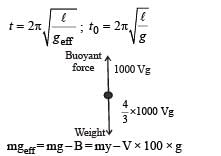

In a simple harmonic oscillator, at the mean position - a)kinetic energy is minimum, potential energy is maximum
- b)both kinetic and potential energies are maximum
- c)kinetic energy is maximum, potential energy is minimum
- d)both kinetic and potential energies are minimum.
Correct answer is option 'C'. Can you explain this answer?
In a simple harmonic oscillator, at the mean position
a)
kinetic energy is minimum, potential energy is maximum
b)
both kinetic and potential energies are maximum
c)
kinetic energy is maximum, potential energy is minimum
d)
both kinetic and potential energies are minimum.

|
Harshitha Nambiar answered |

At the mean position x = 0

The total energy of a particle, executing simple harmonic motion is where x is the displacement from the mean position, hence total energy is independent of x.- a)independent of x
- b)∝ x2
- c)∝ x
- d)∝ x1 /2
Correct answer is option 'A'. Can you explain this answer?
The total energy of a particle, executing simple harmonic motion is where x is the displacement from the mean position, hence total energy is independent of x.
a)
independent of x
b)
∝ x2
c)
∝ x
d)
∝ x1 /2

|
Avantika Saha answered |
At any instant the total energy is
 = constant, where A = amplitude
= constant, where A = amplitudehence total energy is independent of x.
The period of oscillation of a simple pendulum of length L suspended from the roof of a vehicle which moves without friction down an inclined plane of inclination α , is given by- a)

- b)

- c)

- d)

Correct answer is option 'A'. Can you explain this answer?
The period of oscillation of a simple pendulum of length L suspended from the roof of a vehicle which moves without friction down an inclined plane of inclination α , is given by
a)

b)

c)

d)


|
Bhavya Joshi answered |
As shown in the figure, gsina is the pseudo acceleration applied by the observer in the accelerated frame
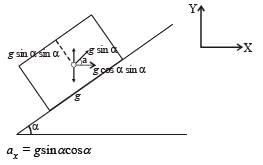
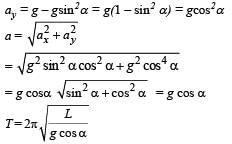
NOTE : Whenever point of suspension is accelerating
use
use

Chapter doubts & questions for Simple Harmonic Motion (Oscillations) - 35 Years Chapter wise Previous Year Solved Papers for JEE 2025 is part of JEE exam preparation. The chapters have been prepared according to the JEE exam syllabus. The Chapter doubts & questions, notes, tests & MCQs are made for JEE 2025 Exam. Find important definitions, questions, notes, meanings, examples, exercises, MCQs and online tests here.
Chapter doubts & questions of Simple Harmonic Motion (Oscillations) - 35 Years Chapter wise Previous Year Solved Papers for JEE in English & Hindi are available as part of JEE exam.
Download more important topics, notes, lectures and mock test series for JEE Exam by signing up for free.

Contact Support
Our team is online on weekdays between 10 AM - 7 PM
Typical reply within 3 hours
|
Free Exam Preparation
at your Fingertips!
Access Free Study Material - Test Series, Structured Courses, Free Videos & Study Notes and Prepare for Your Exam With Ease

 Join the 10M+ students on EduRev
Join the 10M+ students on EduRev
|

|
Create your account for free
OR
Forgot Password
OR
Signup to see your scores
go up within 7 days!
Access 1000+ FREE Docs, Videos and Tests
Takes less than 10 seconds to signup





 = 0.1 cos πt . The phase difference of the velocity of particle 1 with respect to the velocity of particle 2 is
= 0.1 cos πt . The phase difference of the velocity of particle 1 with respect to the velocity of particle 2 is
